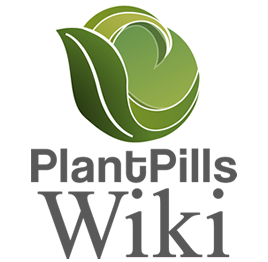
A photo of the PlantPills Gold Standard Shilajit Paste. For more photos, please see the desktop version of this page here.
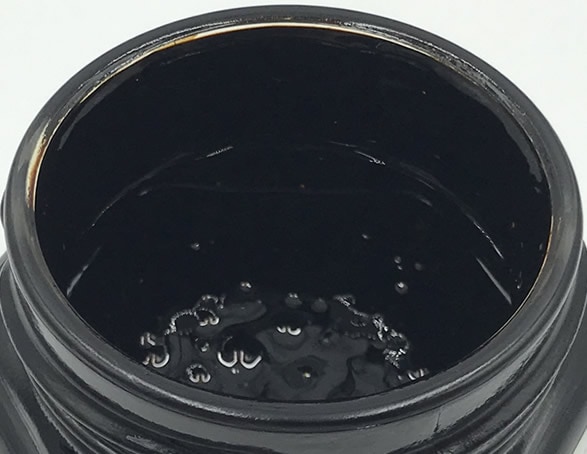
Shilajit, also spelled shilajeet or salajeet, and also known as rock juice, mountain sweat, mountain blood, mountain oil, asphaltum, vegetable asphalt, mumiyo, mumijo, mineral pitch, mineral wax, and fulvic acid minerals, is a dark brown or black resin, paste, or tar-like sticky humic substance[1].
It’s found at altitudes between 1,000 and 5,000 meters, in the mountain regions of the former USSR (Ural, Baykal, Sayan, Caucasus, Altai mountain regions, Kirgysia, Tajikistan, Uzbekistan, and Kazakhstan), as well as in Afghanistan, Bhutan, China, Nepal, Pakistan, and Tibet[2,3].
Shilajit is thought to form as a result of a long-term humification process unique to the environment and conditions of mountainous regions. Plant matter is fermented between layers of rocks, and transformed by microorganisms, resulting in the organic residues losing their original structure[4].
Microbial metabolism produces reduced sugars and amino acids, which undergo non-enzymatic polymerization, to form brown nitrogenous polymers[4].
Unlike a living cell, where the synthesis of biopolymers is governed by the genetic code, there is no established program of any kind in the humification process, so any substances can appear, either simpler or more complex than the original biomolecules. The resulting products again undergo transformation and synthesis reactions, and the process continues indefinitely[10].
The wild and frequent climatic changes in mountainous regions, such as freezing and thawing, and wetting and drying, combined with the intermixing of the reactants with catalytic mineral materials, facilitates the condensation and formation of shilajit[4].
Tests completed on various samples have determined shilajit to be between 500 and 15,000 years old, suggesting that the formation process may take several hundred years[5].
Shilajit is a complex natural mixture of organic and inorganic compounds in a rough 70:30 ratio, with an abundance of trace elements[9,11], and is primarily composed of humus substances, including fulvic acids, humic acids, humin, and hymatomelanic acid[8,9].
Shilajit also contains albuminoids, amino acids, oxygenated biphenyls, coumarin derivatives (benzocoumarin, DBPs; dibenzo-alpha-pyrones), fluorene, mycotoxins (trichothecenes, naptho-l-pyrones and alternariol), organic acids (benzoic acid and its derivatives, hippuric acid, and naphthenic acids), phenolic lipids, polymeric quinines, sterols, tannins, terpenes, and triterpenes[3,6,7].
Classified as an organomineral matter, shilajit also contains copper, zinc, lithium, chromium, silver, cobalt, phosphorus, vanadium, iron, calcium, magnesium, potassium, sodium, iodine, manganese, molybdenum, sulfur and silicon[8,9].
Multiple mechanism of action have been observed in humans and animals, where potential benefits of Shilajit may be attributed to increased adenosine triphosphate (ATP) levels, activation of mitochondrial respiration, activation of Calcium ion (Ca2+) transport, dibenzo-alpha-pyrone (DBP) content, the ability of fulvic acid to chelate minerals and facilitate cellular penetration, and facilitating the regeneration of ascorbic acid (vitamin C).
Adenosine triphosphate (ATP) is found in all forms of life, and is an energy carrying molecule known as the "molecular unit of currency" of intracellular energy transfer[12].
ATP is a precursor to DNA and RNA, is used as a coenzyme, and captures chemical energy obtained from the breakdown of food molecules to provide energy to drive processes such as muscle contraction, nerve impulse propagation, and chemical synthesis[13].
A study on mice found that swimming severely depleted ATP levels in the muscle of mice, and that supplementation with shilajit reduced the depletion, almost doubling the levels of ATP in the muscle. ATP levels in the brain and blood were also increased[14].
An unpublished study on six humans found that supplementation with shilajit increased blood levels of ATP, ATP/ADP ratio, coenzyme Q10 (CoQ10), total adenine nucleotides, adenylate energy charge, and uric acid, significantly increasing energy production and physical exercise[15].
Shilajit contains dibenzo-alpha-pyrones (DBPs), that are capable of permeating through the blood-brain barrier, and may protect brain and nerve tissue from free-radical damage.
DBPs also increase acetylcholine levels in rats, low levels of which have been associated with poor memory, concentration and Alzheimer’s disease[16].
Shilajit has been found to activate mitochondrial respiration but suppresses activity of succinate-oxidase and NADH-oxidase in mitochondrion[17].
The stimulating action of shilajit may be caused by the activation of Calcium ion (Ca2+) transport.
In rats, Shilajit increases superoxide dismutase, catalase, and glutathione peroxidase activities in the frontal cortex and striatum[18,19,20].
Shilajit has also been found to regenerate ascorbic acid, and trap hydroxyl radicals, and NO and SO radicals[21].
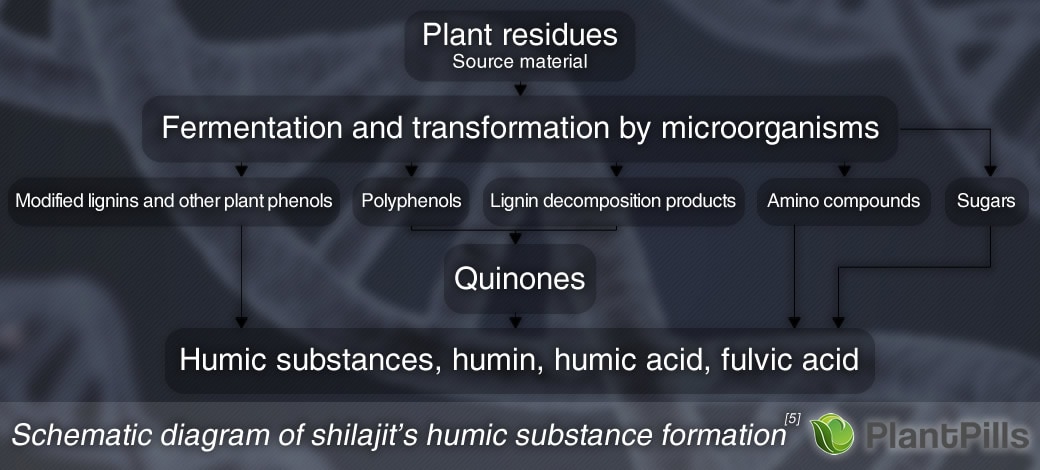
Shilajit is used as a rejuvenator in traditional Russian and Ayurveda medicine[22,23], and has been used in the folk and herbal medicine of several countries for around 3,000 years. Administered both topically on the skin, and internally by swallowing or drinking with water, it has been used as an anti-inflammatory, as an antidote to poisons, and to treat neuralgia, trigeminal neuralgia, radiculitis, skin diseases, dislocations, bone fractures, arthritis, migraine, angina, ear disease, vertigo, gastrointestinal diseases, haemorrhages, genitourinary diseases, diabetes, jaundice, adiposity, enlarged spleen, digestive disorders/acid reflux, epilepsy, nervous diseases, elephantiasis, tuberculosis, chronic bronchitis, asthma, anemia, ameamenorrhea, dysmenorrhea, menorrhagia, eczema, leprosy, anorexia, osteoporosis and bites[24].
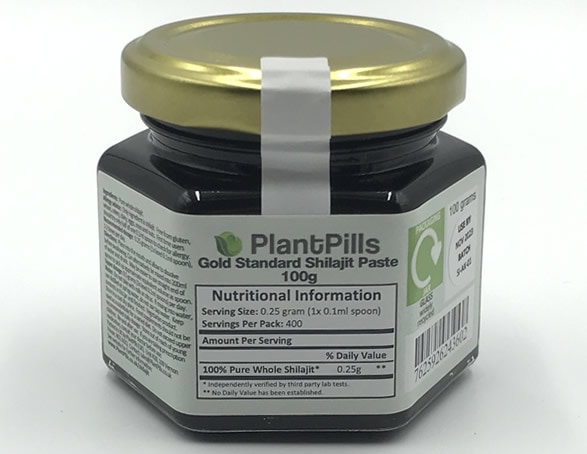
Shilajit also forms part of several medical drugs manufactured by pharmaceutical companies[24], and has been shown in studies to possess antimicrobial activity with respect to staphylococci, streptococci, coliform bacteria, enterococci, and Proteus[25,26]. Studies have found that Shilajit reduced the complex treatment period of patients with pulmonary tuberculosis by three to four times[24], and may act as an antidiabetic agent in addition to enhancing growth hormone levels in diabetic patients[24].
Shilajit has also been shown to cause a decrease in pain, disappearance of inflammation, and quicker healing following burn injuries[27], and cause a more rapid healing in the ear disease suppurative otitis[28] and wounds in general[44], as well as accelerating bone regeneration after bone fractures in animals, children and adults[29,30,31,32,33,34,35].
Shilajit has been shown to have anti-inflammatory properties in humans in the treatment of gum disease[36], osteoarthrosis, rheumatoid arthritis, ankylosing spondylitis, and cervical spondylosis[37], in the prevention of ulcers[38], and in arthritis and swelling in rats[39].
It is possible that Shilajit’s anti-inflammatory properties are due to it containing benzoic acid, fulvic acids, 40-methoxy-6-carbomethoxybiphenyl, and tirucallane-type triterpenoids, as these compounds are known to possess strong anti-inflammatory properties[40,41,42,43].
Shilajit has also been shown to improve the transport of antibacterial drugs to the targeted area of inflammation[45].
In mice, Shilajit stimulates lymphopoietic erythropoiesis in acute radiation disease, resulting in a more rapid restoration of the number of lymphocytes in peripheral blood, bone marrow, and spleen[46].
Positive results have been seen during the treatment of eczema and psoriasis[47], which is thought to be due to the fact that Shilajit contains biphenyl and benzocoumarin compounds, which have significant antiallergic activity, with mast cells stabilized by Shilajit resulting in significantly less degranulation[40,48].
Shilajit contains DBPs, that are capable of permeating through the blood-brain barrier, and may protect brain and nerve tissue from free-radical damage. DBPs in shilajit increased acetylcholine levels in rats, low levels of which have been associated with poor memory, concentration and Alzheimer’s disease[16], and has been shown to improve learning and memory in rats[49,50,51], which has led to it being classified as a “medha rasayana” or nootropic agent[65].
Shilajit has also been found to be an inhibitor of the development of tolerance to morphine in mice[52], and to be effective as a painkiller in rats[64].
It is notable that fulvic and humic acids found in shilajit appear to increase the number and functional activity of macrophages, neutrophils and killer T-cells[53,54]. Humic acids were first discovered to have anabolic properties when given to chickens in 1951, with average body mass increased by 5-7%[55,56,57]. This was confirmed in rats in 1966, which concluded that the body is able to utilize food better when supplementing with shilajit[61]. Fulvic acids may also act as carrier molecules or chelating agents for smaller, more bioactive compounds[58].
Shilajit was secretly used by the former USSR to enhance the physical and mental performance of Olympic athletes and special military forces for nearly 40 years. Applications included reducing stress-related injuries, benefitting recovery, as well as increasing strength and muscle mass. Much of the research conducted by the former USSR into shilajit is classified and has not been released[24,59,60].
Studies have given positive indications for these types of potential benefits[61,62], including some that suggest shilajit may relieve fatigue and increase energy and endurance[14,15].
In men, Shilajit has been found to increase sperm count, sperm motility, testosterone levels and FSH levels[63,66].
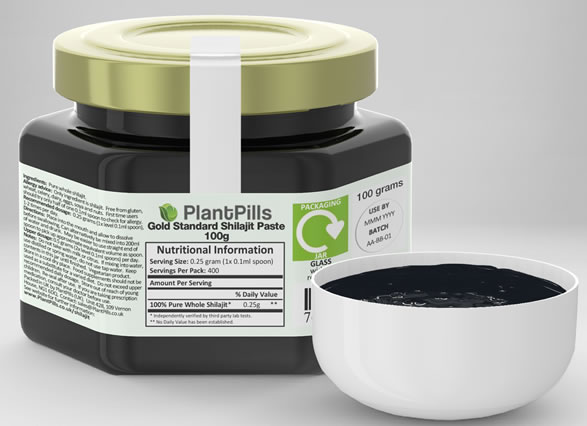
PlantPills Gold Standard Shilajit is collected from the Russian Altai/Altay Mountain Range in Central Asia, an area where Russia, China, Mongolia and Kazakhstan converge[67]. The only processing applied is a simple purification process, to remove anything that is not shilajit. This is performed at low temperatures to preserve the active components that are sensitive to heat.
Care is taken to ensure that nothing is added or taken away, so the shilajit retains its whole, authentic and natural composition.
Shilajit has been used for 3,000 years in its natural form as a sticky tar-like substance, and the majority of research has used shilajit in this form. Applying processing to shilajit to attempt to powder it, or otherwise isolate, extract, refine or standardise it, results in a product that is derived from shilajit, but is no longer natural, whole shilajit. Processing shilajit in this manner means that some original components are missing, and of the remaining ones, some are denatured due to processing methods such as heat.
As a result, processed shilajit and products derived from shilajit do not exhibit the same actions and benefits as natural whole shilajit.
Natural variations in composition and its relative rarity have given rise to adulterated and counterfeit shilajit products[68], and testing methods used to determine humic acid and fulvic acid levels in shilajit have proven unreliable[69].
Due to these issues the Association of Official Analytical Chemists, AOAC International, developed a consensus-driven testing standard for verifying and establishing the contents of humic ores such as shilajit[69].
Any supplier of shilajit should be able to provide the AOAC test performed by a third party laboratory for the current batch. This proves that the shilajit is authentic and genuine, and gives a reliable indication of the humic and fulvic acid levels. If a supplier can’t provide the AOAC test results, the authenticity of the product is unknown.
The AOAC test performed by a third party laboratory for the current batch of PlantPills Shilajit is displayed below. This details humic acid, fulvic acid, moisture, organic matter and sulphur levels.
Also below is the third party laboratory test showing levels of Calcium, Copper, Iron, Magnesium, Manganese, Phosphorus, Potassium, Sodium and Zinc in the current batch.
Additional third party laboratory tests for the current batch viewable below include the microbiological certificate of analysis, heavy metal content and aluminium content.
Aluminium content of some shilajit has been a contentious issue, and should be tested by a third party laboratory for every batch. One serving (0.25g) of PlantPills Shilajit contains less aluminium than a slice of bread, or a chicken breast, or 25 grams of pasta, or 2.5 grams of chocolate[70,71,72].
These tests verify that PlantPills Shilajit is authentic, high quality, and safe for human consumption.
Pack sizes are 100 grams, 200 grams, 500 grams, 1 kilogram, 2 kilograms and 10 kilograms.
Different pack sizes are selectable in the basket.
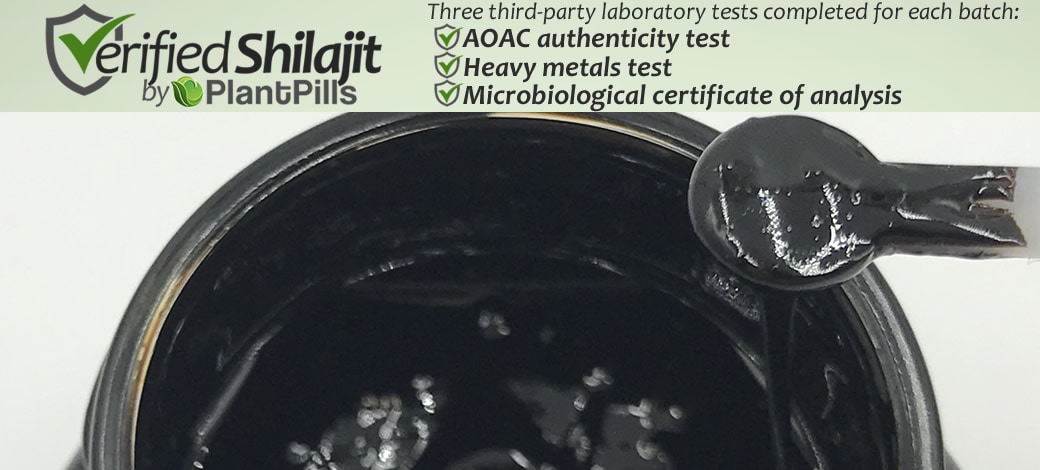
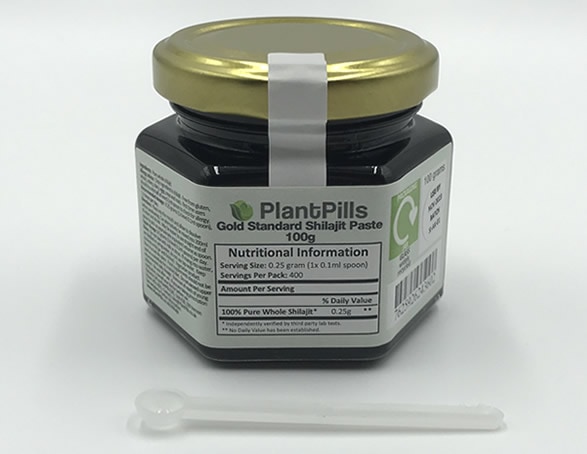
Due to the nature of shilajit, long term storage in plastic containers could result in shilajit reacting with the plastic and possibly absorbing elements from it.
PlantPills Shilajit comes packaged in a glass jar, eliminating any possibility of shilajit reacting with the container during long term storage, and providing an effective barrier against oxygen.
A 0.1ml measuring spoon is included and when filled level, provides a 0.25g serving. However, the consistency of shilajit makes filling the spoon, and then emptying it quite difficult. The dosage and guidelines section goes into more detail, but we recommend using the volume of the spoon as a guide, and placing shilajit on the opposite end of the spoon at roughly the same size.
This can then be taken straight into the mouth, or stirred into body-temperature spring water or re-mineralised distilled water.
Genuine, natural, whole shilajit is a thick, sticky, tar-like resin substance. Shilajit in this form has been used for 3,000 years, and the majority of research has been conducted on shilajit in this form.
Processing shilajit into a different form, such as tablets, capsules, powder or liquid removes some of the components of shilajit, and denatures many others due to the processing involved, such as heat.
Shilajit tablets, capsules, powder or liquid may be derived from shilajit, but it’s no longer in the form that has been so well studied and used for thousands of years, and as such doesn’t exhibit the actions and benefits of the natural whole form.
Any shilajit made available for sale should have a third party laboratory AOAC test for the batch to confirm that the substance is in fact shilajit, and that it is not adulterated or counterfeit. This test also gives reliable measurements of fulvic and humic acid content.
It should also have third party tests for minerals, microbiological analysis, heavy metal content, and aluminium content. We have these tests completed for every batch of PlantPills Shilajit, and publish them on our site, confirming that our shilajit is genuine, and that it contains no dangerous levels of heavy metals or micro-organisms.
Without these tests, it is unknown whether the substance is actually shilajit or not, and may not be safe for human consumption.
It is sensible for anyone who is new to taking shilajit, to initially take just half of one 0.1ml spoon (about 125mg) and monitor themselves for any adverse reactions for 24 hours. If there is no reaction, proceed with supplementation the following day.
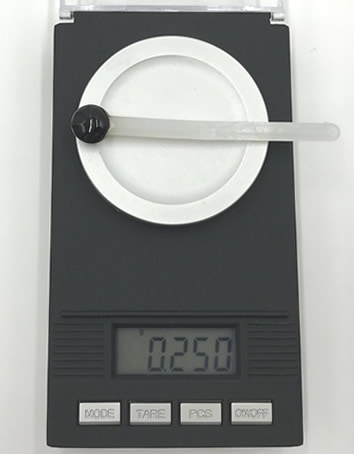
Directions: Place into the mouth and allow to dissolve before swallowing. Can alternatively be mixed into 200ml of water and drunk.
Note: Genuine, natural, whole shilajit has a thick, sticky, tar-like consistency that can be challenging to accurately measure into an exact dose.
When filled level, the included 0.1ml measuring spoon provides a 0.25g serving, but emptying it from the spoon can be challenging.
Using the spoon volume as a guide, the straight end of the spoon can be used to pick up roughly the same size of shilajit. This can then be taken straight into the mouth and allowed to dissolve before swallowing, or stirred into re-mineralised distilled water or spring water.
Note: Tap water is not recommended with shilajit, because humic and fulvic acids contained in shilajit can react with chemicals used in the chlorination process to form disinfection byproducts, which are toxic to humans[73,74].
If water is used, ensure that the water is not chlorinated, such as re-mineralised distilled water, spring water or properly filtered water.
Recommended dosage: 0.25 grams (1x level 0.1ml spoon), 1-2 times per day.
Upper dosage: 0.5 grams (2x level 0.1ml spoons) per day.
Note: It may be beneficial to take one or two days off per week from supplementing with shilajit. There is no evidence to suggest that this is beneficial, but the body can respond positively when given periodic breaks from routine.
Shilajit is cycled when taken in amounts higher than the upper dosage, or when the shilajit is an extract or isolate.
Note: It’s advisable to avoid any citrus food or drink at the same time as taking shilajit, as citrus may increase the bioavailability of aluminium.
It’s also advisable to avoid any milk products at the same time as taking shilajit, as milk may inhibit the action of shilajit by binding with polyphenols[75].
Shilajit has traditionally been applied topically to skin in the region of injuries, and can be done so before applying a plaster, bandage or cling film over the top.
If you are taking prescription medication, consult your doctor before use.
Re-seal jar after use and store in a cool dry place.
Keep contents in the jar until finished.
Please see the label from our 100 gram jar of Gold Standard Shilajit Paste below.

Scientists have not found natural whole shilajit to be toxic in any amount when given to humans or animals[5,60].
Try to keep the lip of the jar clean and free from shilajit. The lid may stick closed if shilajit is spilled on the area where the lid meets the lip or thread of the glass.
Avoid using metal utensils when handling shilajit, plastic or wooden utensils are advisable.
If you are taking prescription medication, consult your doctor before use.
People with urinary stones (urolithiasis) should avoid shilajit.
People who have the genetic disorder PKU (phenylketonuria) should avoid shilajit.
People with gouty arthritis should avoid shilajit.
People with a high uric acid count should avoid shilajit.
Food supplements should not be used as a substitute for a varied diet.
Please find all sources and references listed below. Archived versions of online sources are included in the event that the original material is changed, moved or removed. Please note that none of these sources are affiliated with PlantPills.
| 1 |
Adaptogens: Herbs for Strength, Stamina, and Stress Relief Winston, David; Maimes, Steven Inner Traditions / Bear & Company. pp. 201–204. ISBN 978-1-59477-969-5. 2007. |
| 2 |
Mumie as a kind of natural resources and its signs. Khakimov ZN. Tashkent. PhD Thesis. 1974. |
| 3 |
The need for formulation of Shilajit by its isolated active constituents. Ghosal S, Lal J, Singh SK, Goel RK, Jaiswal AK, Bhattacharya SK. Phytother Res 5:211– 216. 1991. |
| 4 |
Humus chemistry. Genesis, composition, reactions. Stevenson FJ. New York: John Wiley. 1994. |
| 5 |
Medical Drugs From Humus Matter: Focus on Mumie Igor Schepetkin, Andrei Khlebnikov, Byoung Se Kwon Drug Development Research 57:140–159. 2002. |
| 6 |
Shilajit I: chemical constituents. Ghosal S, Reddy JP, Lal VK. J Pharm Sci 65:772–773. 1976. |
| 7 |
Pharmacological actions of Shilajit. Acharya SB, Frotan MH, Goel RK, Tripathi SK, Das PK. Indian J Exp Biol 26:775–777. 1988. |
| 8 |
Mumie liophylisati. Pharmacopoeia Article Republic of Kazakhstan. 1992. |
| 9 |
Silajit. Part II. Determination of metals in Silajit and biological significance of some metals. Peerzada N, Saramani S, Tariq SA. Sci Intern 11:79–82. 1999. |
| 10 |
Humic substances in the biosphere. Orlov DS. Soros Obraz Zh (2):56–63. 1997. |
| 11 |
Introduction in biominerology. Korago AA. St. Petersburg: Nauka. 1992. |
| 12 |
Enzyme-catalyzed phosphoryl transfer reactions Knowles, J. R. Annu. Rev. Biochem. 49: 877–919. 1980. |
| 13 |
Adenosine triphosphate, [mirror] From Wikipedia, the free encyclopedia 2020 |
| 14 |
Beneficial effect of processed shilajit on swimming exercise induced impaired energy status of mice. Bhattacharayya S, Pal D, Gupta AK, et al. Pharmacologyonline 1: 817–825. 2009. |
| 15 |
Technical Data Report. Raju S. Natreon, Inc. 2012. |
| 16 |
System administration of defined extracts from Withania somnifera (Indian ginseng) and Shilajit differentially affects cholinergic but not glutamatergic and gabanergic markers in rat brain. Schliebs R, Liebman A, Bhattacharya SK, Kumar A, Ghosah S, Bigl V. Neurochem Int 30:181–190. 1997. |
| 17 |
Mumie effect on oxidative phosphorylation and enzymes of mitochondrial respiratory chain of rat liver, small and large intestine. Almatov KT, Akhmerov AI. Transact Tashkent Med Inst. 7:11–14. 1977. |
| 18 |
Effects of Shilajit and its active constituents on learning and memory in rats. Ghosal S, Lal J, Jaiswal AK, Bhattacharya SK. Phytother Res 7:29–34. 1993. |
| 19 |
Effects of Shilajit on biogenic free radicals. Bhattacharya SK, Sen AP, Ghosal S. Phytother Res 9:56–59. 1995. |
| 20 |
Antioxidant defense by native and processed Shilajit: a comparative study. Ghosal S, Bhattacharya SK. Indian J Chem 35B:127–132. 1996. |
| 21 |
Interaction of Shilajit with free radicals. Ghosal S. Ind J Chem. 34B:596–602. 1995. |
| 22 |
Joshi: an interpretation of Ayurvedica findings on Shilajit. Tiwari VP, Tiwari KC. J Res Indigen Med 8:57. 1973. |
| 23 |
Mumie as a kind of natural resources and its signs. Khakimov ZN. Tashkent. PhD Thesis. 1974. |
| 24 |
Medical Drugs From Humus Matter: Focus on Mumie Schepetkin I, Khlebnikov A, Se Kwon B. Drug Development Research 57:140–159. 2002. |
| 25 |
A comparative evaluation of antibacterial properties of Mumie and penicillin. Shakirov DS. Antibiotiki 12:248–251. 1967. |
| 26 |
Treatment of infected wounds with Mumie asil in experiment. Shakirov DS. Exp Surg Anesthes 6:36–39. 1969. |
| 27 |
Application of Mumie in therapeutic practice. Anisimov VE, Shakirzyanova RM. Kazan Med J 63:65–68. 1982. |
| 28 |
The use of Mumie for treatment of postoperative trepanized cavities of the middle ear. Psakhis BI, Aizenberg SG. J Ear Nose Throat Dis (5):57–61. 1976. |
| 29 |
The organization of medical rehabilitation of patients, operated apropos of vertebral-cerebrospinal injury. Perederko IG, Solenii VI, Tolubayev NS, Marchenko AA, Kirpa YuI. Second Congress of Neurosurgeons of Ukraine Odessa. 3:Abstract 6. 1998. |
| 30 |
On the question of Mumie dosage and special features of bone fractures healing with its application. Ismailova VN. Med J Uzbek (9):69–70. 1965. |
| 31 |
Influence of Mumie on bone regeneration and blood alkaline phosphatase after bone fracture in an experiment. Shakirov AS. Ortop Travmatol Protez 26:24–27. 1965. |
| 32 |
Treatment of long tubular bone fractures with Mumie asil preparations in experiments and clinical conditions. Kelginbaev NS, Sorokina VA, Stefanidu AG, Ismailova VN. Exp Surg Anesthes 18:31–35. 1973. |
| 33 |
Reparative regeneration of the bone tissue under the effect of Mumie asyl. Tkachenko SS, Rutskii VV, Grachev IR. Ortop Traum Protez 40:49–52. 1979. |
| 34 |
Treatment of long tubular bone fractures with Mumie asil preparations in experiments and clinical conditions. Kelginbaev NS, Sorokina VA, Stefanidu AG, Ismailova VN. Exp Surg Anesthes 18:31–35. 1973. |
| 35 |
Effects of Mumie on bone regeneration in patients subjected to surgery for osteoarticular tuberculosis. Suleimanov I. Ortop Travm Protez 33:64–66. 1972. |
| 36 |
The complex treatment of paradontosis patients with application of Mumie asil. Habilov LL. Tashkent. PhD Thesis. 1971. |
| 37 |
The treatment of deforming osteoarthrosis by non-specific bio-stimulator Mumie. Soliev TS. Med J Uzbek (8): 19–21. 1983. |
| 38 |
Application of Caucasian Mumie in the treatment for experimental ulcers of gastric and duodenum. Kozlovskaya VI. Vrach Delo (4):23–25. 1971. |
| 39 |
Antiulcerogenic and antiinflammatory studies with Shilajit. Goel RK, Banerjee RS, Acharya SB. J Ethnopharmacol 29: 95–103. 1990. |
| 40 |
Antiulcerogenic activity of fulvic acids and 40-methoxy-6-carbomethoxybiphenyl isolated from Shilajit. Ghosal S, Singh SK, Kumar Y. Phytother Res 2:187–191. 1988. |
| 41 |
The need for formulation of Shilajit by its isolated active constituents. Ghosal S, Lal J, Singh SK, Goel RK, Jaiswal AK, Bhattacharya SK. Phytother Res 5:211– 216. 1991. |
| 42 |
Viper venom-induced inflammation and inhibition of free radical formation by pure compound (2-hydroxy-4-methoxy benzoic acid) isolated and purified from anantamul (Hemidesmus indicus R. BR) root extract. Alam MI, Gomes A. Toxicon 36:207–215. 1998. |
| 43 |
Inhibition of trypsin and chymotrypsin by antiinflammatory triterpenoids from Compositae flowers. Rajic A, Akihisa T, Ukiya M, Yasukawa K, Sandeman RM, Chandler DS, Polya GM. Planta Med 67:599–604. 2001. |
| 44 |
Effect of Mumie on the healing of suppurative wounds. Tazhimametov BT, Usmanov MU, Dzhuraev KA, Sharipov NI, Zulfikarov K. Clin Surg (1):51–52. 1987. |
| 45 |
Mumie as a pathogenetic agent in the treatment of tuberculosis. Agzamov RA, Arifkhanova SI, Vakhidova GA. Probl Tuberk 7:49–52. 1988. |
| 46 |
Effect of Mumie preparation on lymphopoiesis in acute radiation sickness. Rogozkin VD, Tukhtaev T. Bull Exp Biol Med 65:110–111. 1968. |
| 47 |
Application of Mumie in therapeutic practice. Anisimov VE, Shakirzyanova RM. Kazan Med J 63:65–68. 1982. |
| 48 |
Mast cell protecting effects of Shilajit and its constituents. Bhattacharya SK, Dasgupta G, Bhaduri J, Mukhopadhyay M, Goel RK, Dey R. Phytother Res 3:249–252. 1989. |
| 49 |
Effects of Shilajit on rat brain monoamines. Bhattacharya SK, Ghosal S. Phytother Res 6:1163–1164. 1992. |
| 50 |
Effect of Shilajit on memory, anxiety and brain monoamines in rats. Jaiswal AK, Bhattacharya SK. Ind J Pharm 24:12–17. 1992. |
| 51 |
Effects of Shilajit and its active constituents on learning and memory in rats. Ghosal S, Lal J, Jaiswal AK, Bhattacharya SK. Phytother Res 7:29–34. 1993. |
| 52 |
Effects of Shilajit on the development of tolerance to morphine in mice. Tiwari P, Ramarao P, Ghosal S. Phytother Res 15:177–179. 2001. |
| 53 |
Humate-induced activation of human granulocytes. Riede UN, Zeck-Kapp G, Freudenberg N, Keller HU, Seubert B. Virchows Arch B Cell Pathol Incl Mol Pathol 60:27–34. 1991. |
| 54 |
Process for preparing synthetic soil-extract materials and medicaments based thereon. Laub RJ. USA Patent 5,945,446. 1999. |
| 55 |
The role of humic acid in plant nutrition and humus fertilizers. Khristeva LA. Trudi Pochv Inst VV Dokuchaeva. 38:108–184. 1951. |
| 56 |
The effect of sodium humate on metabolism and resistance in highly productive poultry. Stepchenko LM, Zhorina LV, Kravtsova LV. Nauch Dokl Vyss Shkoly Biol Nauki (10):90–95. 1991. |
| 57 |
The content of free amino acids in the tissues of broiler chicks administered sodium humate in the ration. Zhorina LV, Stepchenko LM. Nauchnye Dokl Vyss Shkoly Biol Nauki (10):147–150. 1991. |
| 58 |
The core structure of Shilajit humus. Ghosal S, Lal J, Singh SK. Soil Biology Biochem 23:673–680. 1991. |
| 59 |
Selected herbals and human exercise performance. Bucci LR. Am J Clin Nutr 72(2 suppl): 624S-636S. 2000. |
| 60 |
Safety and Efficacy of Shilajit (Mumie, Moomiyo) Stohs SJ. Phytother. Res. 2013. |
| 61 |
Effect of Gurmar and Shilajit on body weight of young rats. Gupta SS, Seth CB, Mathur VS. Indian J Physiol Pharmacol 9:87–92. 1966. |
| 62 |
Effect of the nonspecific biogenic stimulators Pentoxyl and Mumie on metabolic processes. Shvetskii AG, Vorobeva LM. Vopr Med Khim 24:102–108. 1978. |
| 63 |
Clinical evaluation of spermatogenic activity of processed shilajit in oligospermia. Biswas TK, Pandit S, Mondal S, et al. Andrologia 42: 48–56. 2009. |
| 64 |
Pharmacological actions of Shilajit. Acharya SB, Frotan MH, Goel RK, Tripathi SK, Das PK. Indian J Exp Biol. 26(10): 775-7. 1988 |
| 65 |
Traditional Medicine, Proceedings of an International Seminar. Mukherjee, Biswapati. Hotel Taj Bengal, Calcutta India. Oxford & IBH Publishing, New Delhi. pg 308-319. Nov. 7-9 1992. |
| 66 |
Clinical evaluation of purified Shilajit on testosterone levels in healthy volunteers Pandit S, Biswas S, Jana U, De RK, Mukhopadhyay SC, Biswas TK. Andrologia, Volume 48, Issue 5, Pages 570-575. 2016. |
| 67 |
Altai Mountains, [mirror] From Wikipedia, the free encyclopedia 2020 |
| 68 |
Characterization and biological activities of humic substances from mumie. Schepetkin IA, Khebnikov AI, Ah SY, et al. J Agric Food Chem 51: 5245–5254. 2003. |
| 69 |
A new standardized method for quantification of humic and fulvic acids in humic ores and commercial products., [mirror] Lamar RT, Olk DC, Mayhew L, Bloom PR. J AOAC Int. May-Jun;97(3):721-30. 2014. |
| 70 |
Safety Evaluation of Dietary Aluminum, [mirror] Madhusudan G.Soni, Susan M.White, W.GaryFlamm, George A.Burdock Regulatory Toxicology and Pharmacology, Volume 33, Issue 1, Pages 66-79, February 2001. |
| 71 |
Aluminium content of selected foods and food products, [mirror] Thorsten Stahl, Hasan Taschan, Hubertus Brunn Environmental Sciences Europe, December 2011. |
| 72 |
Aluminium content (third party lab test) of PlantPills Shilajit: 259ppm. 0.25g = 64.75μg Aluminium content of bread: 2ppm[71]. 100g (two slices) = 200μg Aluminium content of chicken: 0.66ppm[70]. 300g (two breasts) = 198μg Aluminium content of pasta: 4ppm[71]. 50g = 200μg Aluminium content of chocolate: 39ppm[71]. 5g = 195μg |
| 73 |
Dihaloacetonitriles in drinking water: Algae and fulvic acid as precursors., [mirror] Oliver, Barry G. Environmental Science & Technology. 17 (2): 80–83. 1983. |
| 74 |
Dihaloacetonitriles in Dutch drinking waters., [mirror] Peters, Ruud J.B.; De Leer, Ed W.B.; De Galan, Leo. Water Research. 24 (6): 797. 1990. |
| 75 |
Interactions between milk proteins and polyphenols: Binding mechanisms, related changes, and the future trends in the dairy industry. Yildirim-Elikoglu, S., & Erdem, Y. K. Food Reviews International, 34(7), 665–697. 2017. |

To purchase the PlantPills Gold Standard Shilajit Paste, please see the desktop version of this page here.
